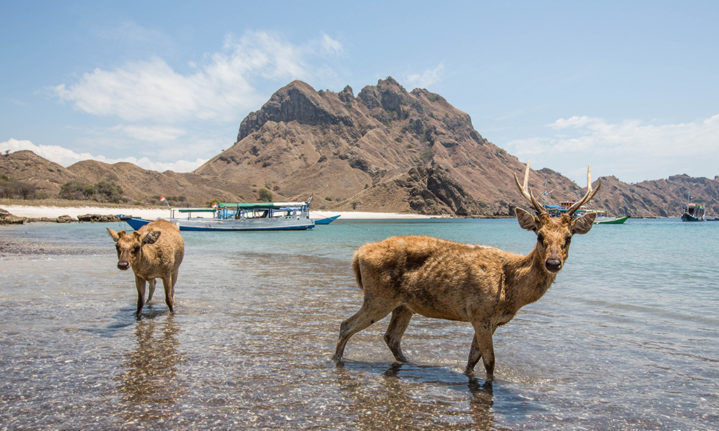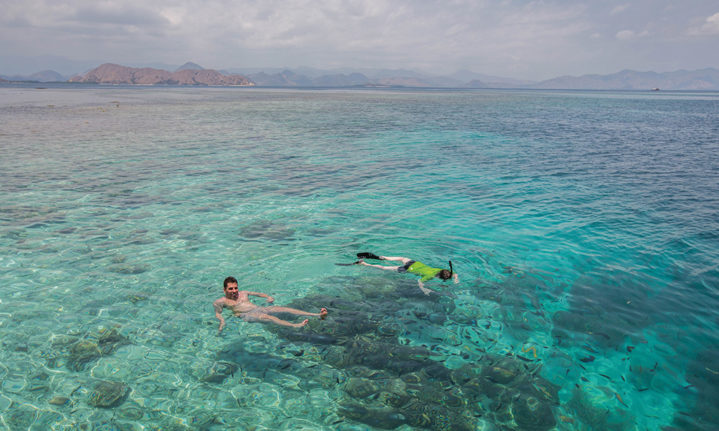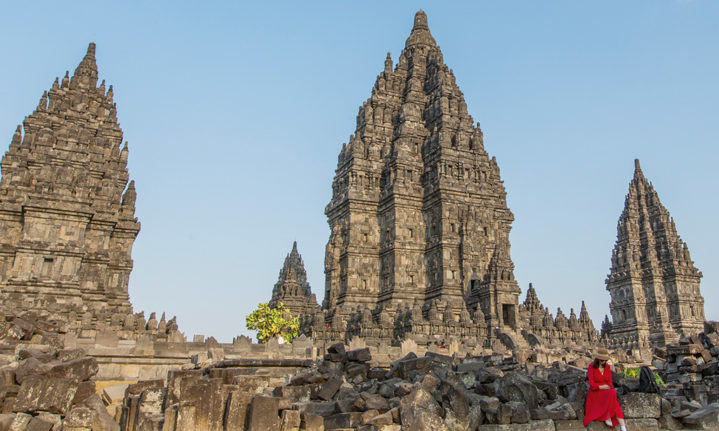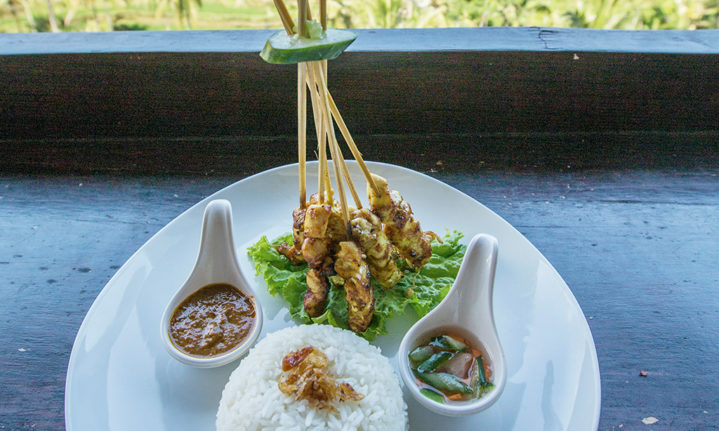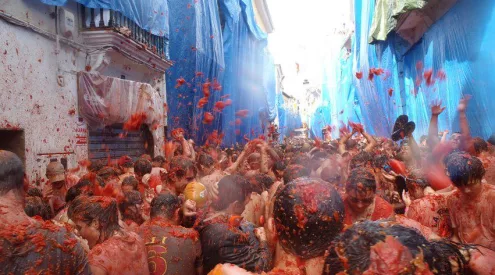This land of exotic wildlife and ancient customs is so seductive that its new moniker makes perfect sense: Wonderful Indonesia.
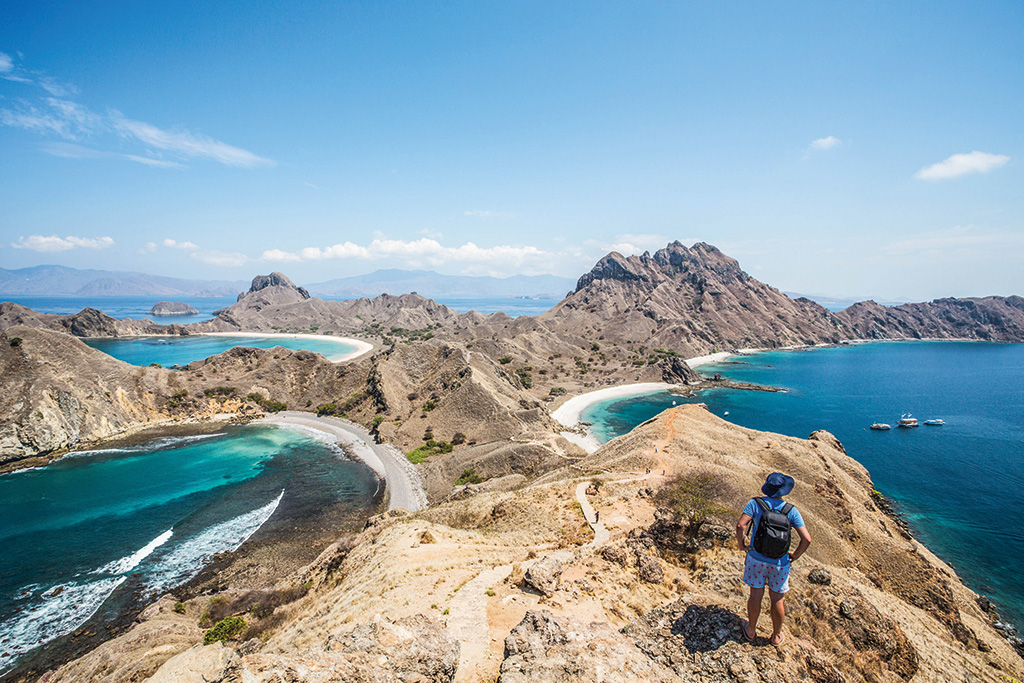
Padar is one of the islands we visited on our Komodo tour. Curiously, it has beaches of three different colours; at one the sand is a pearly white, another charcoal black and a third is a baby pink. Image credit: Matthew Sterne
We were on foot in search of dragons. Not much stirred in the bright morning light as our group walked single file along a dusty trail on Rinca Island in Indonesia.
The air was dry and the vegetation a toasted brown. Two cockatoos screeched in a tree high above. With sweat dripping off us, we followed our guide who carried a long stick for protection. Komodo dragons are the largest lizards in the world. They have skin like chainmail armour, eat their young, have serrated teeth and are venomous. Somehow a stick didn’t seem like it would count for much should we need to slay a dragon.
Despite their brutal nature, dangerous encounters are unlikely. There’s a story they tell on Komodo Island, just north of Rinca, about the Dragon Princess. A long time ago, she gave birth to twins, a human boy called Gerong and a female dragon called Ora. They separated at birth and reunited as adults in the forest, over a shared love of deer meat. Ever since then, the islanders have considered the Komodos their sacred ancestors and have lived in relative harmony with them, barring the odd invasion of their stilted homes.

Timor deer cool off in the waters of Padar Island on a sweltering day. Image credit: Matthew Sterne
We reached a nesting site. ‘Females dig fake nests to throw off predators that eat their eggs, mostly other Komodo dragons…’ said our guide. Before he could finish his sentence, one of the scaly beasts strode out of the bushes. Imposing and with a twisting gait, this relic of evolution began digging. She put her head down, her claws ripping at the dirt, flinging it behind her like a comical gold digger. We were 15 metres away on the other side of some bushes and watched, transfixed, as she went about her business undeterred by our excited whispers and nervous laughter.
We continued walking and soon found an orange-and-yellow-spotted juvenile resting on the ground in the shade. We were told this was somewhat unusual as younger Komodos normally stay in trees until they’re two years old to avoid attacks from bigger dragons. Towards the end of our walk, a fully grown male Komodo with its belly just off the ground, a yellow forked tongue flickering and saliva dripping from its mouth, sauntered across our path. Without breaking stride or looking in our direction, he disappeared into the bushes.
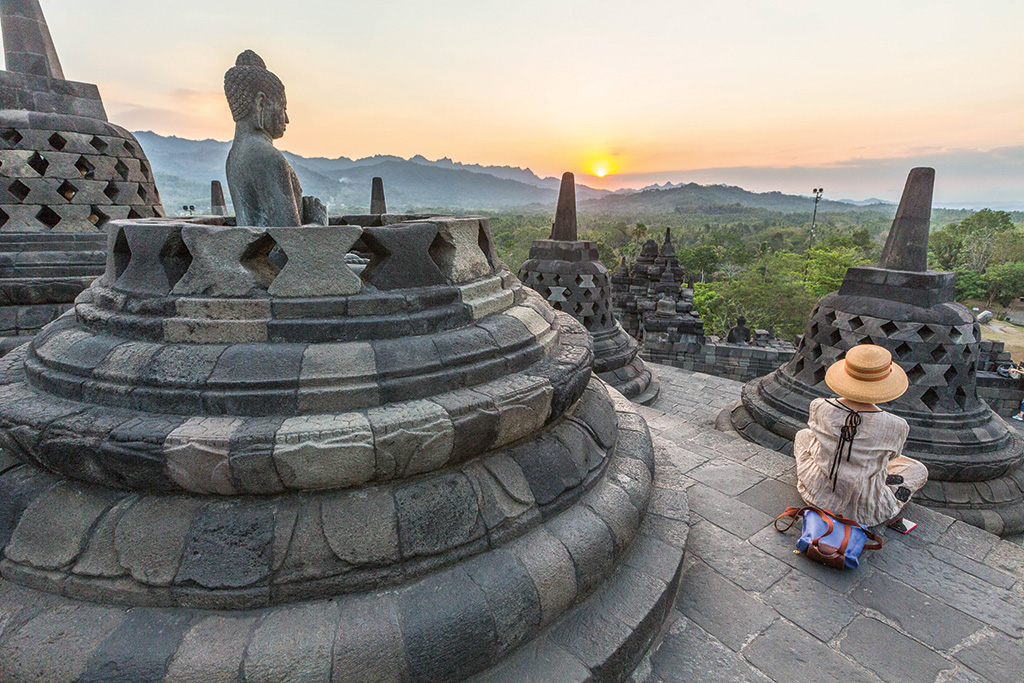
Borobudur Temple has 2 672 relief panels and 504 Buddha statues. Image credit: Matthew Sterne
I was on a 10-day media trip with Afronesia Tours, taking in some of the country’s top attractions. Although there are five main islands in Indonesia – Sumatra, Java, Borneo, Sulawesi and New Guinea – we would visit only Java, home to half of Indonesia’s population, and two smaller islands, Bali and Flores, with day trips to even smaller islands to see the Komodos. Our group of South Africans consisted of a few journalists and two radio-competition winners, Brenda Farrell Bullough and Sharon Bannister, loud and constantly laughing friends who were always in the midst of some kind of crisis. We joked that their TV travel show would be called, ‘Where’s my passport?’ At each destination, we met a new local guide, thrilled that we were visiting Indonesia and excited to show us around. Indra Diwangkara with the colourful batik shirts ushered us around Jakarta, Aan Purnama Yoga guided us in Yogyakarta (both cities in Java), Risal Diansah Putera met us in Flores and told us about living on Komodo, and Raka Juniawan, a jolly fellow accompanied by a silent sidekick, showed us around Bali.
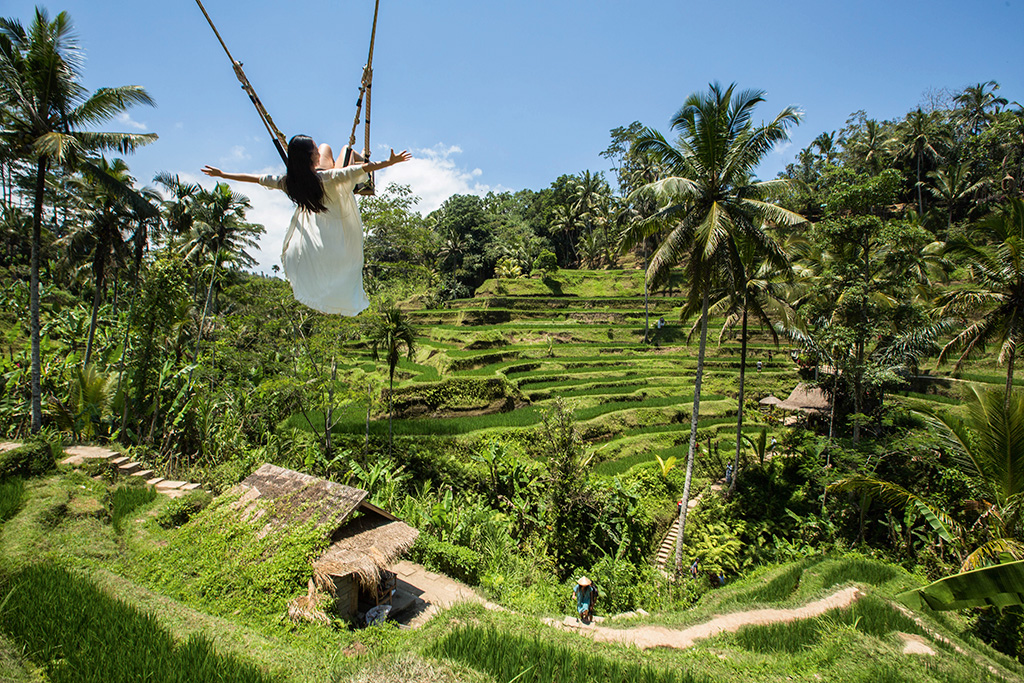
The newly added swings at the Tegalalang rice terrace near Ubud in Bali are a dream come true for aspiring Instagram models. Image credit: Matthew Sterne
The islands of Indonesia jut out of the ocean like the scales of a mythical sea creature. They breathe fire, too, with 127 active volcanoes across the archipelago. There are a staggering 17,508 islands, of which 4,042 disappear at high tide and nearly 7,000 are inhabited. These isles are home to uncontacted tribes, head-hunters, giant flowers and a breathtaking biodiversity – its rainforests contain 12% of the world’s mammal species and 17% of all bird species. Visitors go in search of orangutans in steamy jungles, explore the world’s top dive sites and ride unimaginably perfect surf breaks.
Indonesia is vast – it’s the fourth most populated country in the world and has the third longest coastline. The westernmost province, Aceh, is 5,200 kilometres from the easternmost one, Papua. (That’s roughly the distance between the borders of South Africa and Egypt.) There are 633 ethnic groups with more than 700 languages, although almost everyone can speak Indonesian.

Local boys, jumping off a nearby jetty, gave us bread to attract large shoals of reef fish. Image credit: Matthew Sterne
After our encounters with the lizards of Rinca (adjacent to Komodo Island) we were whisked to nearby bays where we snorkelled amid a colourful array of reef fish. The coral was not in the best shape, though, as it’s experienced bleaching in recent years due to increased sea temperatures. To see the best of the underwater life – the rays, turtles, sharks and coral – you need to scuba.
That evening, we visited the Labuan Bajo fish market on Flores. About 40 stalls lined the street. Each had a half-drum fireplace and an electric fan blowing over the coals, shooting tiny sparks into the path of bewildered tourists. Sellers called out to passers-by, pointing to their tables piled high with fish so fresh they looked as though they’d just jumped out of the water and plopped onto the table. On show were bright blue parrot fish, red and white snapper, striped zebra fish, shimmering barracuda, tuna and mahi-mahi. There were also containers brimming with clams, prawns, squid, crabs and super-size lobsters. Behind the stalls, tables and chairs looked onto an unlit harbour. Smoke from the fires wafted across the bay, past the boats bobbing in the water and rose into the starry sky.
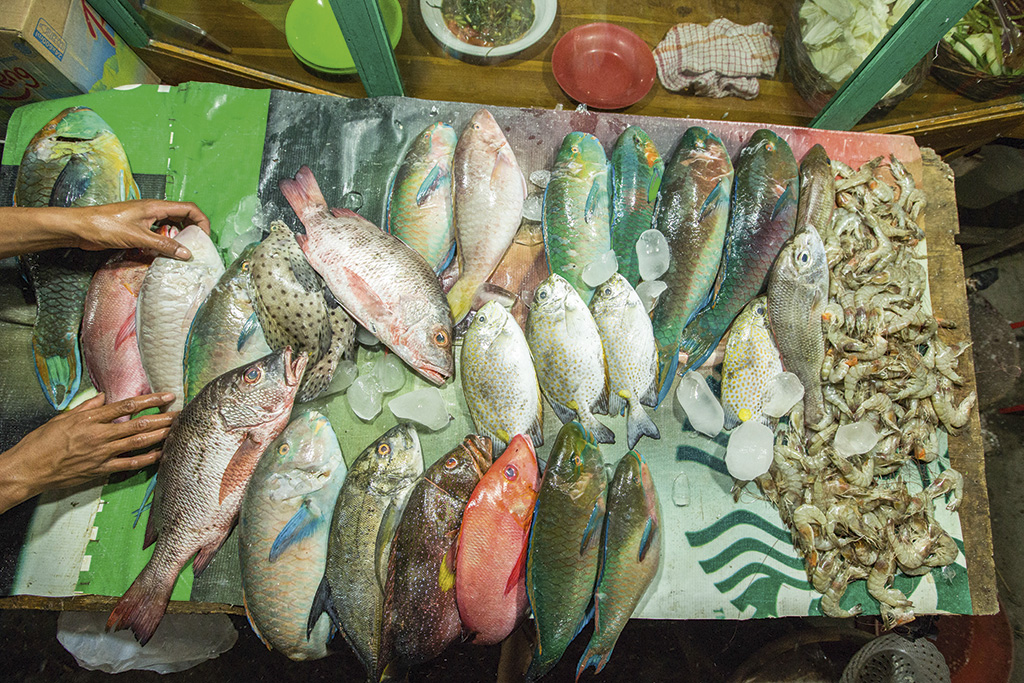
We spent ages marvelling at the variety of fresh fish at the Labuan Bajo night market. Image credit: Matthew Sterne
On this hot sticky night, we sat drinking freshly squeezed juices and marvelled at a lively social scene devoid of alcohol. The fish – butterflied, basted and grilled over coals – were bigger than the serving plates, and accompanied by green beans and a cucumber salad. The calamari was both crunchy and soft, closer to the texture of fish than the rubbery calamari we know at home. We ate as much as we could, before succumbing to a sated stupor, all of us in need of a little help to get up.
In her travel book Indonesia Etc. Elizabeth Pisani describes how the nation was cobbled together from a string of spice-rich sultanates. Centuries ago, the people of the archipelago’s islands didn’t think of themselves as part of a larger whole. The moving back and forth of merchants did, however, create an openness and acceptance of differences among ordinary islanders that’s evident today. Pisani writes: ‘It translates into a voluptuous hospitality, and makes these islands a deeply seductive place to explore.’
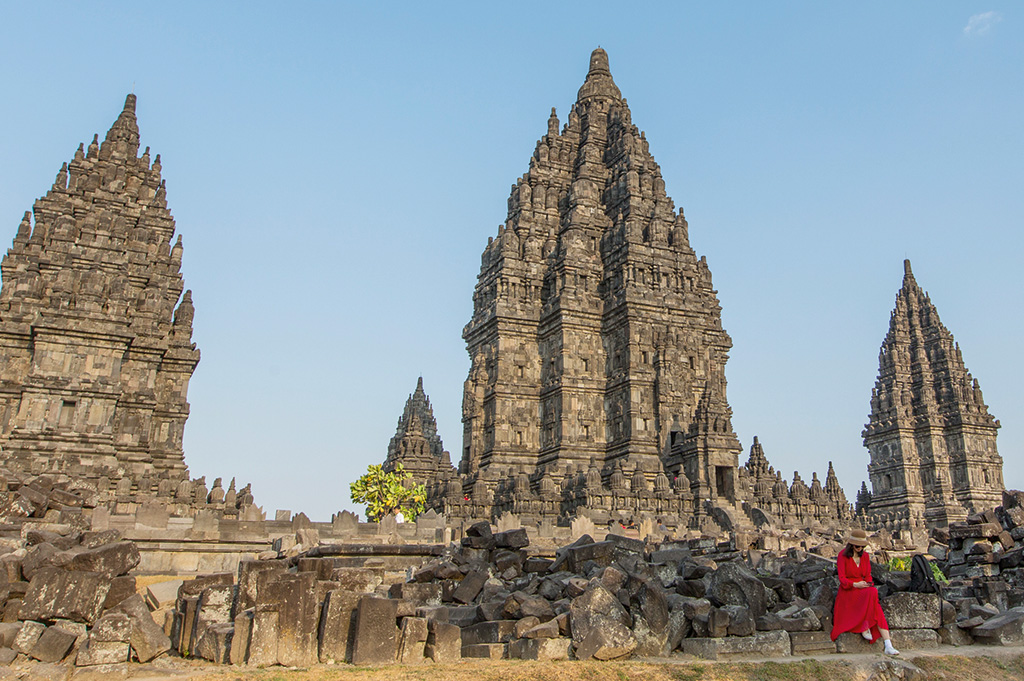
The best time to visit Prambanan, Indonesia’s biggest Hindu Temple, is in the late afternoon. Image credit: Matthew Sterne
This sentiment is exemplified in Bali, Indonesia’s most popular destination. We explored the markets in the trendy town of Ubud, visited the picturesque Tegalalang rice terrace and watched a kecak dance performance at the open-air Uluwatu Temple while the sun set behind the clifftop stage. It was in Java’s Yogyakarta, however, that we delved into the country’s spiritual side. Yogyakarta is a sultanate where locals have fused Islam with regional history and ancient Javanese culture. Nearby are two religious complexes. Prambanan is the largest Hindu temple in Indonesia while Borobudur is the biggest Buddhist temple in the world.
One morning, we visited a puppet maker. Wayang, as it’s known, is an ancient form of storytelling in which leather puppets perform behind a screen to traditional gamelan music. Performances go through the night, with the puppet master revered as a holy man. A craftsman showed us his intricately designed puppets, carved from ox hide, and explained the meaning behind them. This developed into a conversation about spiritualism. ‘It doesn’t matter where you come from or what you look like, we all have the same soul,’ he said.
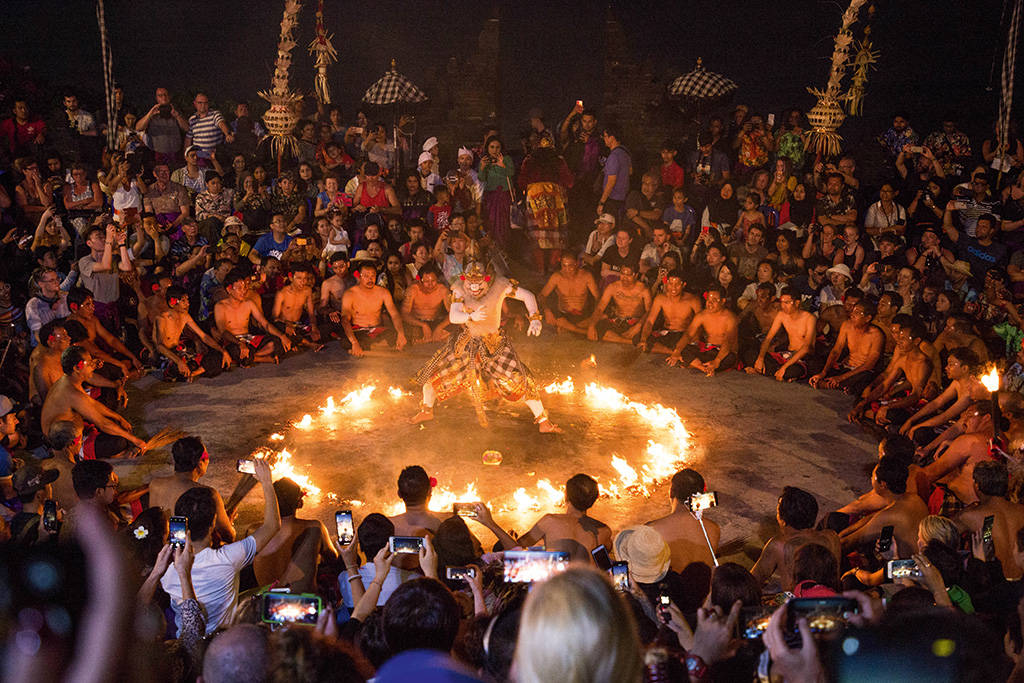
The kecak performance at Uluwatu Temple is based on the famous Hindu story, Ramayana, and climaxes with a lively fire dance. Image credit: Matthew Sterne
Indonesians like to say there’s a red thread (benang merah) that binds the islands and their cultures into a single nation. To me, the red thread seems to be a shared kindness – everywhere our group went, we were greeted like old friends and treated with genuine affection. It was this aspect of my journey, more so than the riverside lunches of nasi goreng (fried rice) and rendang (beef stew), temple visits and wildlife encounters, that made this land of ancient stories and fabled creatures so enjoyable to explore – a place where everyone shares the same soul, even humans and the world’s largest lizard.
Dutch Connection
Following 350 years of Dutch colonial rule, remnants of their language remain in commonly used words such as piesang, presies, kantoor, asbak and handdoek. In the 17th and 18th centuries, many Indonesians were sent to South African shores as slaves. The most notable Indonesian to arrive was Sheikh Yusuf of Makassar, who was exiled to South Africa and subsequently established Islam at the Cape.
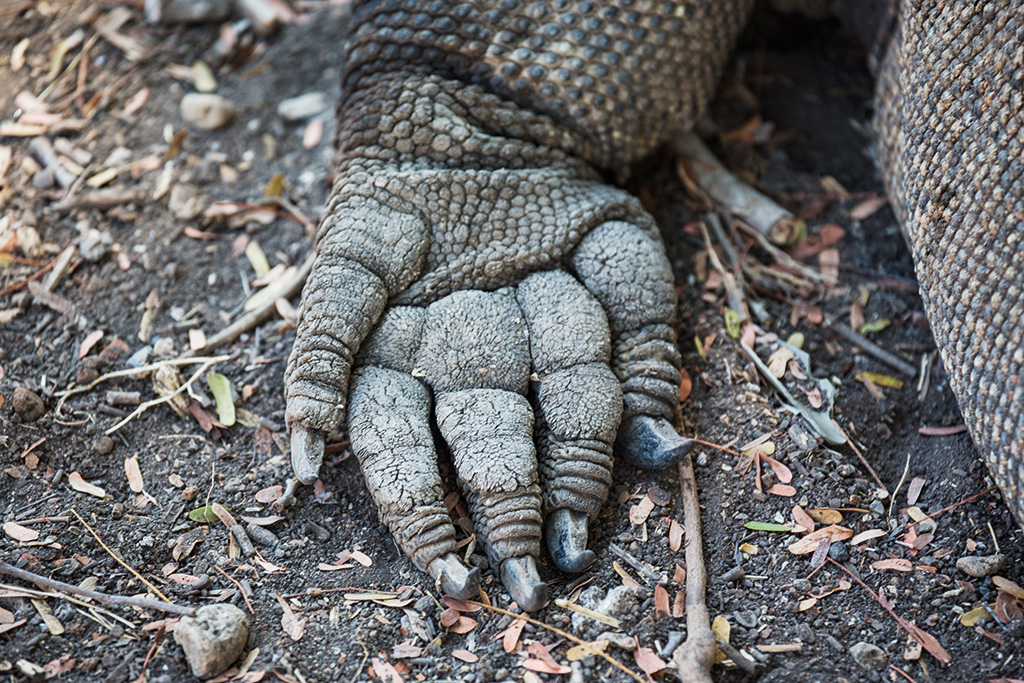
Komodo dragons use their tongues to sample the air and are able to detect carrion nearly 10 kilometres away. Image credit: Matthew Sterne
Here Be Dragons
• The Komodo dragons reach more than three metres and weigh over 100kg.
• For decades, their highly bacterial saliva was assumed to be responsible for their bites being so dangerous. In 2009, however, researchers found they have venom glands.
• Females can fertilise their own eggs and give ‘virgin births’. This asexual method of reproduction is called parthenogenesis.
• Komodos can eat 80% of their body weight and prey on animals such as water buffalo, deer, pigs and even humans.
• When threatened, they can regurgitate to lessen their weight in order to move quickly.
• Dragons will cannibalise their young and full-grown adults if food is scarce.
• Under their scaly skin they’re completely covered in mail-like armour built out of tiny bones.
Plan Your Trip
Getting There
Singapore, Qatar, Emirates and Ethiopian Airlines all fly to Jakarta, from about R9,500 return. travelstart.co.za
When To Go
Temperatures hover around 28°C, so Indonesia is close to being a year-round destination. Monsoon season is from December to February with November and March also prone to rain, but generally limited to bursts.
Need To Know
A 30-day visa is granted on arrival to South Africans at no cost. Indonesia is a very affordable destination, so rand-wielding South Africans can treat themselves to upmarket accommodation and quality meals. Islam is widely practised, so alcohol is not always available and local customs should be respected.
Getting Around
Choose your chariot: boat, train or plane? Fast boats and ferries take tourists to smaller islands, such as from Bali to the Gili Islands. An excellent train system links all the main cities on Java. Internal flights with local carriers are similarly priced to SA domestic flights.
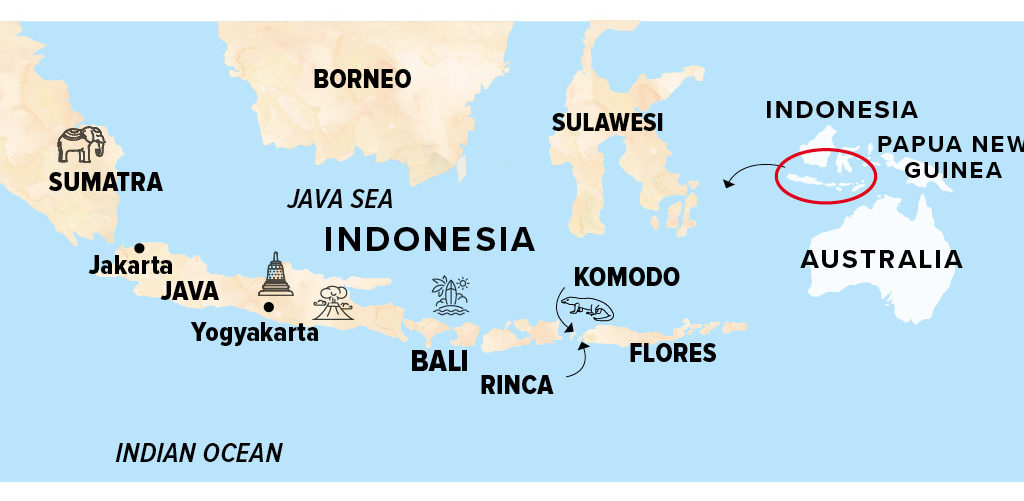
How To Do It
Afronesia Tours is run by Ega von Wielligh, a gregarious Indonesian who now calls Wellington in the Western Cape home. She’s been sending South Africans on Indonesian holidays for five years and focuses on helping her travellers explore in style and comfort, but with the insight of a local perspective. A similar 10-day Indo-highlights trip – including all meals, four-star accommodation, international and domestic flights between islands, private transfers in an air-conditioned vehicle, tours, English-speaking guides and entrance tickets – starts from R28,000 pp. They also arrange custom diving and surfing trips. afronesiatours.co.za
Stay Here
Le Meridien is a refuge from the clamour of Jakarta’s streets. There’s a beautiful pool and its vast restaurant serves a feast of Indian, Japanese, Indonesian and European cuisine. From R1,100 pp sharing. marriott.com
Phoenix Hotel in Yogyakarta recently turned 100 and once belonged to a spice baron. With high ceilings, Art Deco finishes and balconied rooms, it has a strong colonial feel. From R500 pp sharing. all.accor.com
La Prima Hotel on Flores Island has stunning sunset views from its ocean-facing rooms and is a good spot to stay while exploring nearby Rinca and Komodo islands. From R600 pp. laprimahotel.mynetwork solutions.com
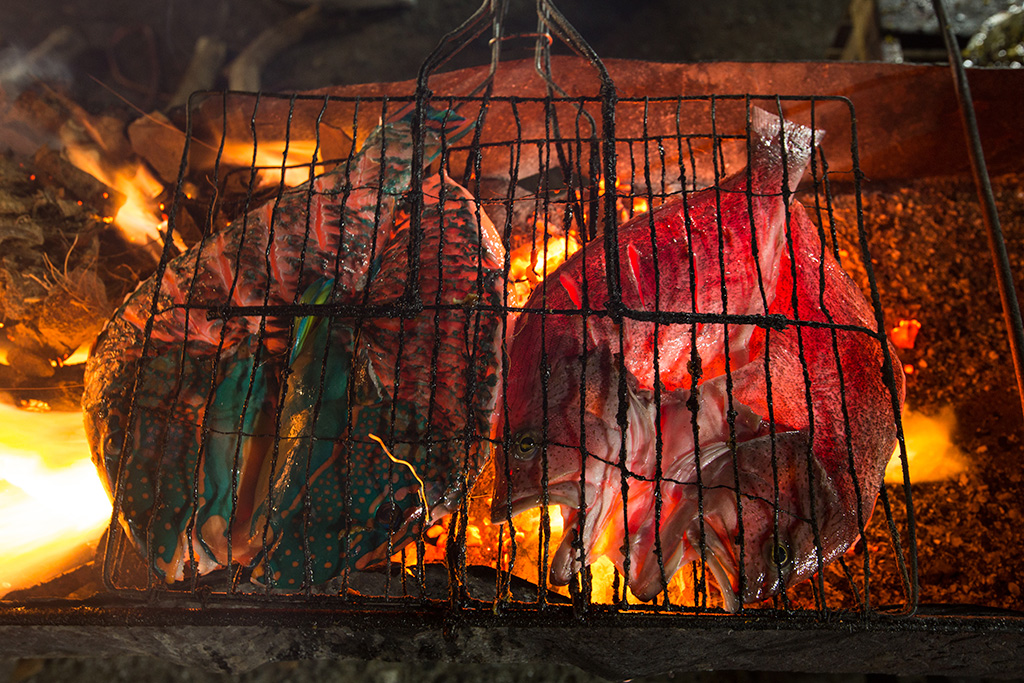
Image credit: Matthew Sterne
Do This
Visit Jakarta, a huge city with a population of about 12 million. Stop here for one night if you want to break up your journey or have an interest in its colonial past, which is best seen at the Bank Museum or National Museum. Also try one of the restaurants or a mall – there are 183 of them in the city!
Visit Prambanan in Yogyakarta. Indonesia’s biggest Hindu temple is characterised by its towering stone spires. The epics of Vishnu, Shiva and Brahmin adorn its massifs. Entrance is R230 pp.
Visit Borobudur in Central Java. Constructed during the 9th century, it’s the largest Buddhist temple in the world and is decorated with 2,672 relief panels and 504 Buddha statues. Sunrises and sunsets are particularly impressive here. Entrance is R355 pp.
Take a boat trip to Komodo and Rinca islands. Komodo is home to nearly 2,000 dragons and the largest specimens. We visited in scorching midday heat and the only lizards we saw were sleeping near the cafe. On Rinca, however, we went earlier and were rewarded with great sightings. My advice is to go to both as early as possible. Tours can be arranged from Labuan Bajo on Flores Island.
Visit the Tegalalang rice terrace in Ubud, Bali. This popular spot of verdant rice crops in a valley is a photographer’s dream. Entrance is R10.
Watch a kecak dance at Uluwatu Temple. The nightly performance adapts the famous Ramayana Hindu epic, and plays out in front of a Balinese sunset. R100 pp.
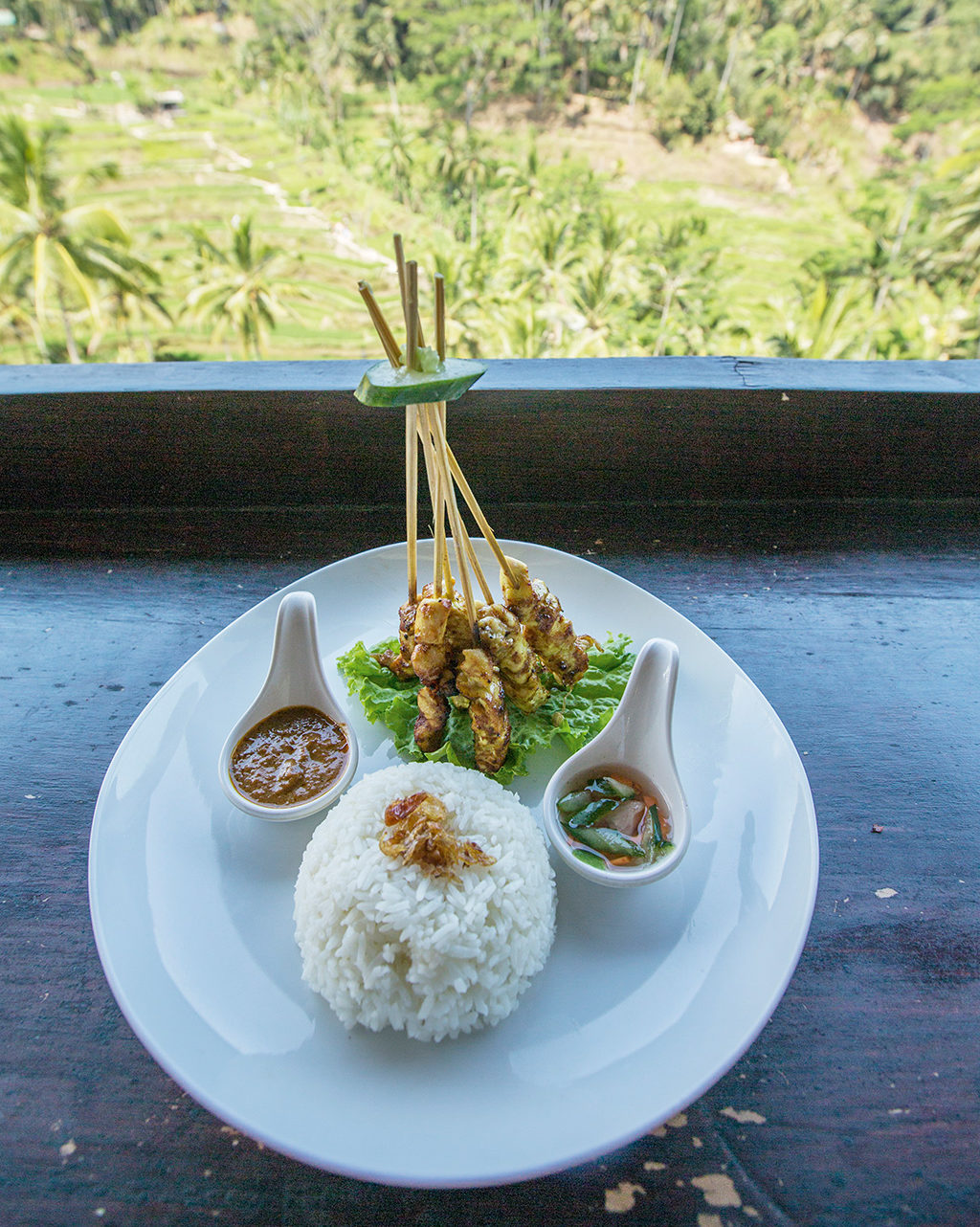
Image credit: Matthew Sterne
Eat This
Indonesia’s food is varied and lauded the world over, with some distinctive dishes that make my mouth water just writing about them:
Beef rendang – Cooked for hours, the gravy of this famous curry bubbles away until the beef is tender.
Satay – Chicken on a stick dipped in a silky-smooth peanut sauce: so simple, but so good.
Nasi goreng – Considered the national dish, you’ll encounter the fried rice anywhere from humble street-food carts to high-end restaurants.
Gado-gado – This vegetable salad contains beans, spinach, potatoes, tofu and tempeh in a peanut sauce.
This article was first published in the March 2020 issue of Getaway magazine.
Get this issue →
All prices correct at publication, but are subject to change at each establishment’s discretion. Please check with them before booking or buying.











